Author: Jinit Jain
Ahilyabai Holkar, the Maratha Queen like no other who constructed and restored Hindu temples which stand tall even today
*Ahilyabai Holkar is fondly remembered for constructing hundreds of temples, ghats, pilgrimage centres, Dharamshalas but rebuilding of Kashi Vishwanath Temple is considered as her greatest achievement. *

PM Narendra Modi on Monday, December 13, 2021, inaugurated the Kashi Vishwanath Corridor Project in Varanasi, restoring an array of temples to their past glory. With the inauguration of the hallowed temple corridor project, PM Modi has once again burnished his credentials as the most potent preserver of the Hindu heritage in the recent times.
As PM Modi buckles down the task of fulfilling the promises he made while contesting the Lok Sabha elections from Varanasi constituency in 2014, one of them being transforming it into a “city of temples”, he did not fail to acknowledge the role of historical figures who helped in conserving the city’s holy character.
In his inaugural speech, PM Modi paid floral tributes to Ahilyabai Holkar, Maharaja Ranjit Singh among other people, who played a pivotal role in reconstruction and renovation of Kashi Vishwanath in the past.
PM said, “The role of Mata Ahilyabai Holkar in the reconstruction of the temple is noteworthy. Maharaja Ranjit Singh sent 23 man (920 KG) of gold to the temple.” He said after Mata Ahilyabai Holkar, the expansion of the Kashi Vishwanath Dham had happened now.
And not just in words but in deeds too, PM Modi and the Centre paid homage to Maratha Queen Ahilyabai Holkar for her momentous contribution in preserving the heritage of Kashi Vishwanath. A figurine of Maharani Ahilyabai Holkar has been put up at the sprawling campus of the Kashi Vishwanath Dham, which was adorned with flowers for its inauguration on Monday. In addition to this, large posters of the Maratha queen were also held up in the premises of the corridors.
Who was Ahilyabai Holkar?
Ahilyabai Holkar was one of the most well-known queens to have presided over the Maratha Empire in the 18th century. Born in May 1725 in the village of Chaundi, in present-day Ahmednagar district of Maharashtra, Maharani Ahilyabai Holkar was the Holkar Queen of the Maratha Malwa kingdom.
She was not born in the royal lineage and was the hereditary noble Queen of the Maratha Empire. When she was 8-years-old, she was spotted by the acclaimed Lord of the Malwa territory, Malhar Rao Holkar, while she feeding the poor. Struck by her compassion and empathy for the destitute, Malhar Rao betrothed her to his son.
However, she lost her husband in the battle of Kumbher when she was just 29. After her husband’s death, she tried to end her life with the practice of Sati but was stopped by her father-in-law. She later ascended the throne and became the ruler of Indore on 11 December 1767.
In opposition to the prevailing culture of the time which disallowed women from pursuing education, Ahilyabai Holkar was an educated woman. She was homeschooled by her father. Perhaps, it was her education and knowledge that helped her to pull together the kingdom of Malwa after the demise of her husband and father-in-law.
Ahilyabai ruled for nearly three decades and was conferred with the title of ‘The Philosopher Queen’ by a British historian John Keyas. In her praise, he said: “Ahilyabai Holkar, the philosopher-queen of Malwa, had evidently been an acute observer of the wider political scene.”
Ahilyabai Holkar-The pioneer of temple construction and restoration
Though Ahilyabai Holkar was an astute queen and quite adept in handling court matters, she was best known for being the pioneer, builder and preserver of the Hindu temples across the length and breadth of the country. From Somnath in the west, to the Kashi Vishwanath in the east, Holkar dedicated her life towards renovating and reconstructing temples that were victims of the ravages of the time or were subjected to assault and plunder by Muslim invaders.
She built temples at Srinagar, Haridwar, Kedarnath, Badrinath, Rishikesh, Prayaga, Varanasi, Naimisharanya, Puri, Rameshwaram, Somnath, Nasik, Omkareshvar, Mahabaleshwar, Pune, Indore, Srisailam, Udipi, Gokarna, Khatmandu etc. She built and restored temples everywhere across India except for territories controlled by Afghans, Nawabs & the British.
River Ganga holds special importance as per Hindu scriptures. Regarded as sacred by Hindus, the river is embodied as the goddess Ganga in ancient texts and art. The water of river Ganga is considered as holy, with ritual bathing being an integral part of Hindu pilgrimage. The water, reverentially called as gangajal, was also used in various pujas performed in Hindu temples. Ahilyabai Holkar arranged for supplying water from the river Ganga collected at Gangotri to be received by temples across the country, including temples as far away as in Kerala, Tamil Nadu and Karnataka.
The Maratha Queen’s contribution in rebuilding Kashi Vishwanath Temple
She is fondly remembered for constructing hundreds of temples, ghats, pilgrimage centres, Dharamshalas around her kingdom but rebuilding of Kashi Vishwanath Temple is considered as her greatest achievements of all.
Her contribution in restoring Kashi Vishwanath temple was particularly significant. The temple had stood tall for centuries before becoming an eye sour for the Mughals. The Islamic rulers, who were on the mission to destroy anything that was against Islam, saw Kashi Vishwanath Dham as one of the main targets challenging the supremacy of their faith.
On April 18, 1669, Islamic ruler Aurangzeb gave the order to demolish Kashi Vishwanath Temple. In his order, he had written that the temple was the place where “the foolish Pundits teach evil knowledge from junk books.”
On the explicit orders from Mughal emperor Aurangzeb, Kashi Vishwanath Dham, one of the holiest Hindu sites of pilgrimage, was plundered, desecrated, demolished & converted into Gyanvapi Mosque in 1669. The current structure and the form of the Kashi Vishwanath Temple could be attributed to Ahilyabai Holkar, who got the structure reconstructed in 1776. Then in 19th century, Maharaja Ranjit Singh adorned the temple with ‘golden’ shikhar.







